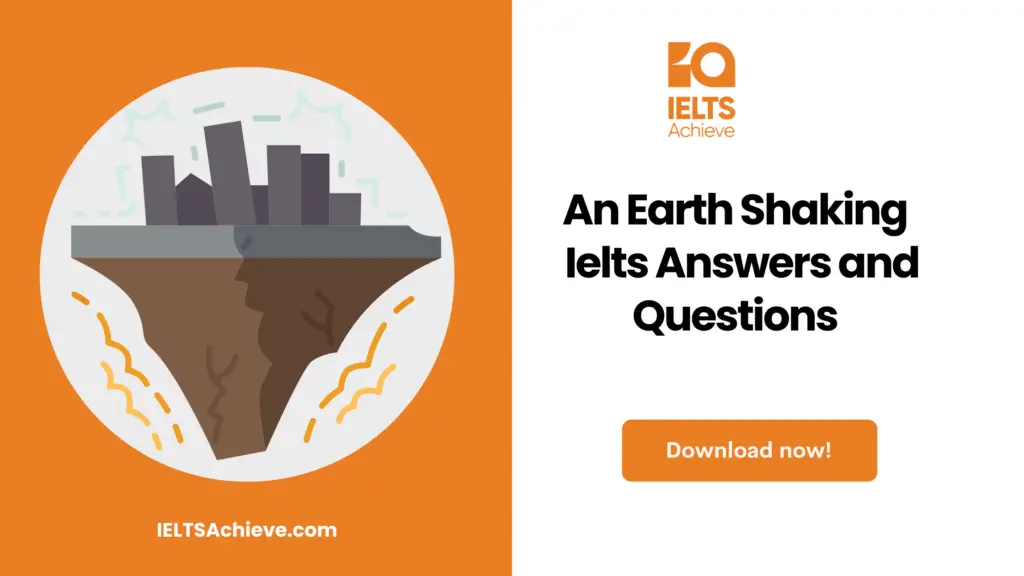The Blog post contains the following IELTS Reading Questions:
- IELTS Reading Matching sentence endings
- IELTS Reading Diagram labeling
- IELTS Reading Short Answer question

IELTS Reading Passage – An Earth-Shaking Discovery
An Earth-Shaking Discovery
A report published in the journal Nature has entirely altered the perspective of this planet and the resources present on it. The things done by Crick and Watson for Biology and Einstein for Physics, similar were done by Fred Vine, Drummond Matthews, and the authors of Tts for Earth Sciences. As a result, new zones of scientific research are still surfacing.
Yet neither man is much remembered or acknowledged. Vine and Matthews’ work served as evidence that continents do, in fact, move over the surface of the earth. The way we seek for resources such as oil and minerals is strongly affected by this information, which has also made it feasible for us to anticipate most volcanic eruptions and decipher seismic patterns. Remarkably, however, knowledge of the Earth’s dynamic mobility aids in understanding long-term shifts in the global climate. Despite how valuable their work was, neither guy earned enough acknowledgment or popularity.
German meteorologist Allred Wegener actually first put forth the ideology of continental drift in 1915. While South America and Africa fit together as well as a jigsaw puzzle, Wegener discovered substantial fossil proof that the two continents were once connected. None took him seriously; in fact, a large percentage of geologists made fun of him. Because he was not a geologist, he was seen as an outsider, which contributed to some of this. Vine believes that Wegener’s inability to explain how whole continents could potentially move even an inch, let alone dance to the beats of time across the world, was the main reason for the contempt.
The Scottish geologist Arthur Holmes theorised in the 1920s that the Earth’s convection currents “might grow sufficiently strong to push the two parts of the original continent apart!” Harry Hess, an American, suggested the concept that molten material rising in a convection flow at the mid-ocean ridges consistently generates new seafloor in the late 1950s. But neither could actually show any supportive evidence. It was nothing more than an intuition that it had to be plausible, but science demands more than an instinct.
Vine, a graduate student at Cambridge, was given the responsibility to examine one of the new magnetic surveys of the ocean bed since he had been fascinated in the continents’ accurate fit since he was 14. He discovered what he terms “parallel zebra swipes of normal and reversed magnetism” along the mid-ocean ridge. What’s most notable was that these stripes were symmetrical on every side of the ridge crests. There must be a logic for this. The theory implied by the young Vine and his mentor Matthews was that the magnetic stripes were produced by the creation of a new ocean floor after molten rock surfaced at the mid-ocean ridges and stretched out on either side of the ridge.
The molten rock formed a weak magnetic field perpendicular to the magnetic field of the earth as it hardened. In the early 1960s, it was only beginning to be realised that the Earth’s magnetic field periodically flipped, changing magnetic north into magnetic south and vice versa. The new sea bed was keeping count of these magnetic field flips. The history of the ocean floor was captured like a huge tape recording. The creation of new sea beds pushed the old ones aside, resulting in a broader ocean and a divergence of the continents on each side. In other words, they had found the missing element of Wegener’s theory that explains how continents drifted apart. The earth sciences were not the same again.
Plate tectonics, the theory that only a few solid plates form the Earth’s surface and are shifted around by an expanding sea floor, was confirmed by the end of the 1960s following evidence of global sea bed spread. It was recognised that mountains are created when two plates clash and that the borders of these plates are where most earthquakes and volcanoes occur. Except for a few orthodox believers, everyone in the geological field accepted this as fact.
In Vine’s opinion, the most fascinating and noteworthy research is primarily focused on how shifting continents impact the environment worldwide: “The allocation of continents and the opening and closing of ocean gates among continents have had a significant impact on climates and have ended up causing somersaults from Icehouse Earth to Greenhouse Earth.” The name “Earth Systems Science” was coined out of the awareness that the hydrosphere, atmosphere, and biosphere of the planet are all closely allied to its shifting continents and internal deep activities. The truth revealed by Vine and Matthews acted as an acorn from which the magnificent oak tree of science has blossomed. Vine is extremely supportive of earth systems sciences’ holistic approach and also thrilled that everything has come together. Instead of the solitary stand that geologists maintained during the 20th century, he claimed to believe that a comprehensive approach to the sciences would be more efficient in improving our knowledge of the planet: there was an extraordinary polarisation of science, and he was stuck between the boundaries. This idea was repugnant to him. He believes that all environmental research should be integrated.
An Earth Shaking Discovery IELTS Reading Questions
Questions 1-4
Complete each sentence with the correct ending A-G from the box below.
Write the correct letter A-G in boxes 1-4 on your answer sheet.
| A. | something which could not possibly be true. |
| B. | matters beyond simply the movement of continents. |
| C. | matters that had not received much attention for some time. |
| D. | something arrived at by intuition that could not be demonstrated. |
| E. | matters requiring different research techniques. |
| F. | something misunderstood at first but later seen as a breakthrough. |
| G. | something that had already been observed. |
- Wegener’s conclusions were greeted as ____________.
- The theories presented by both Holmes and Hess concerned ___________.
- The work done by Vine and Matthews has had implications concerning _____________.
- Wegener attempted to provide an explanation of ____________.
Questions 5-9
Label the diagram below.

5. _____________
6. _____________
7. _____________
8. _____________
9. _____________
Questions 10-13
Answer the questions below using NO MORE THAN THREE WORDS for each answer.
Write your answers in boxes 10-13 on your answer sheet.
10. As a result of Vine and Matthews’ work, which branch of science has arised?Answer: __________
11. What was the theory named, which was concerned with the Earth’s structure being formed due to the sea bed spreading out?Answer: __________
12. What was the term used by Vine to describe the approach which he believed the study of Earth should be done?Answer: __________
13. In Vine’s opinion, what was highly influenced by the movement of continents?Answer: __________
An Earth Shaking Discovery Reading Answers With Explanations
1. A
2. D
3. B
4. G
5. mid(-)ocean ridge(s) / ridge crest(s)
6. molten rock rose
7. (Earth’s) magnetic field
8. parallel / symmetrical / magnetic (zebra) stripes
9. pushed aside / apart
10. Earth Systems Science
11. plates tectonics
12. integrated
13. climates

